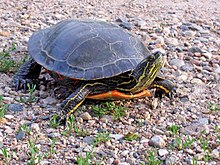
Back سلحفاة مزركشة Arabic سلحفاه مزركشه ARZ Петниста блатна костенурка Bulgarian নকশী কচ্ছপ Bengali/Bangla Tortuga pintada Catalan Chrysemys picta CEB Želva ozdobná Czech Zierschildkröte German Βαμμένη χελώνα Greek Painted turtle English
| Painted turtle | |
|---|---|

| |
| Western painted turtle | |
| Scientific classification | |
| Domain: | Eukaryota |
| Kingdom: | Animalia |
| Phylum: | Chordata |
| Class: | Reptilia |
| Order: | Testudines |
| Suborder: | Cryptodira |
| Family: | Emydidae |
| Genus: | Chrysemys |
| Species: | C. picta
|
| Binomial name | |
| Chrysemys picta (Schneider, 1783)
| |
The painted turtle (Chrysemys picta) is a type of turtle that lives in North America. It lives in slow-moving fresh waters, from southern Canada to northern Mexico, and from the Atlantic to the Pacific. They prefer to live in wetlands that are covered in water for long periods of time, and that have plants growing through the water.[3] Fossils show that the painted turtle existed 15 million years ago.[1]
The adult painted turtle is 13–25 cm (5–10 in) long. The male is smaller than the female.[4] The turtle's top shell is dark and smooth, without a ridge. Its skin is green to black with red, orange, or yellow stripes on its neck, legs, and tail.[5]
The turtle eats aquatic plants, algae, and small water creatures including insects, crustaceans, and fish. Painted turtles mostly eat in the water. They can find and catch prey even when the water is very cloudy.[6] Predators, such as rodents, canines, and snakes often eat the eggs and young turtles. The adult turtles' hard shells protect them from most predators.[7]
Painted turtles are cold-blooded: they cannot make their own heat. They rely on heat from their surroundings, so they are active only during the day. In the morning, and after they come out of the water, they will sit in the sun for a few hours to warm up.[8] During winter, the turtle hibernates, usually in the mud at the bottom of water bodies.[9] The turtles mate in spring and autumn.[10] Females dig nests on land and lay eggs between late spring and mid-summer. Hatched turtles grow until sexual maturity: 2–9 years for males, 6–16 for females.[11][12]
- ↑ 1.0 1.1 Ernst & Lovich 2009, p. 184–185.
- ↑ "Chrysemys picta". IUCN Red List of Threatened Species. Retrieved 2013-10-19.
- ↑ Cosentino, Bradley (September 11, 2010). "Wetland hydrology, area, and isolation influence occupancy and spatial turnover of the painted turtle, Chrysemys picta". Landscape Ecology. 25 (10): 1589–1600. doi:10.1007/s10980-010-9529-3. S2CID 38488888.
- ↑ Healey, Mariah. "Painted Turtle Care Sheet". ReptiFiles. Retrieved 2022-01-18.
- ↑ Cohen, Mary (October 1992). "The painted turtle, Chrysemys picta". Tortuga Gazette. 28 (10): 1–3. Retrieved 2011-01-05.
- ↑ Grosse, Andrew (1 September 2010). "Effects of turbidity on the foraging success of the eastern painted turtle". Copeia. 2010 (3): 463–467. doi:10.1643/CE-09-162. S2CID 83648930.
- ↑ Ernst, Barbour & Lovich 1994, p. 294.
- ↑ Ernst, Barbour & Lovich 1994, p. 282–283.
- ↑ Ernst, Barbour & Lovich 1994, p. 284.
- ↑ Ercelawn, Aliya. "Reproduction". Herpetology Species Page. Prof. Theodora Pinou (Western Connecticut State University Biology and Environmental Sciences). Archived from the original on 2012-03-10. Retrieved 2011-02-06.
- ↑ Ernst, Barbour & Lovich 1994, p. 287.
- ↑ "Painted turtle research in Algonquin provincial park". The Friends of Algonquin Park. 2005. Archived from the original on 2007-10-11. Retrieved 2010-09-17.
